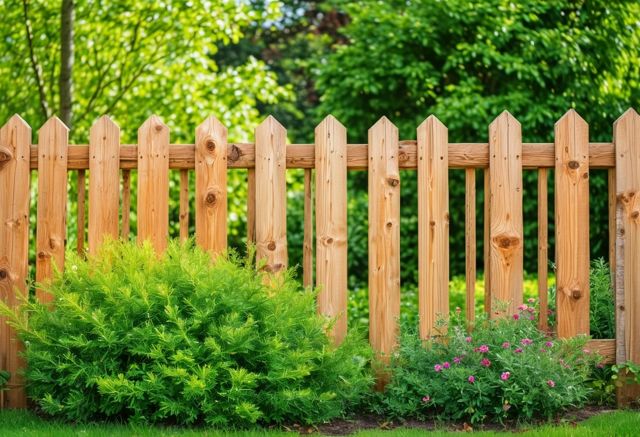Affordable pine fencing solutions combine cost-effectiveness with durability, offering prices between $18.50 and $46.50 per linear foot. Pressure-treated pine resists rot and pests, ensuring a long-lasting and economical fencing option for homeowners.
Introduction to Pine Fencing
Pine wood is a popular choice for residential fencing thanks to its affordability and versatility. Treated pine wood panels offer an economical solution compared to pricier woods like cedar or redwood.
Here are some key characteristics of pine fencing:
- Affordability: Costs range between $18.50 and $46.50 per linear foot.
- Versatility: Can be installed vertically or horizontally.
- Durability: Pressure-treated to resist rot and pests.
Proper selection of pine panels is crucial. It’s important to choose dry and well-treated panels to avoid issues like warping or twisting after installation. This ensures a durable and long-lasting fence.
Pine fences come in various styles to meet different needs:
- Picket and post-and-rail fences offer a classic look.
- Stockade and vertical-board fences provide enhanced privacy.
- Horizontal and louvered designs add a modern touch.
To prolong the life of pine fences, it is recommended to stain and seal the wood to guard against water and insect damage. Pressure-treated pine is especially resistant to mildew and rot, ensuring longevity. Regular maintenance, such as replacing any rotted wood or damaged hardware, is essential for the fence’s upkeep.
Overall, pine wood fencing offers a blend of affordability, versatility, and durability, making it an excellent choice for homeowners seeking cost-effective fencing solutions.
Cost-Effectiveness of Pine Wood
Pine wood stands out as an affordable option for fencing due to various factors. It combines cost-effectiveness with durability, making it a popular choice for many.
Key advantages of pine wood:
- Affordability: Pine wood is generally less expensive than other types of wood like cedar or redwood.
- Abundance: Pine trees grow faster and are more widely available, which keeps the costs down.
- Treatment: Pressure-treated pine wood resists rot and insects, extending its lifespan without significantly increasing the price.
Comparison with other woods:
- Cedar: While cedar is naturally resistant to pests and weather, it is more costly. It also requires less maintenance, but the initial investment is higher.
- Redwood: Known for its durability and beautiful appearance, redwood comes with a premium price tag. Its longevity is unmatched, but it can be cost-prohibitive.
Pine wood’s cost-benefit relationship makes it a prudent choice for homeowners, property managers, and contractors looking to balance quality and budget. Pine wood fencing thus proves to be an economical and durable option for diverse fencing needs.
Weather Resistance Through Treatment
Pine wood can endure weather challenges through specialized treatment processes. These treatments enhance its durability, ensuring it withstands harsh elements. Here are some key treatments:
- Pressure-Treatment: Pine wood is infused with preservatives under high pressure, penetrating deep into the wood fibers. This makes the wood resistant to rot, fungi, and insect damage.
- Water-Repellent Treatment: This involves applying a water-repellent solution, preventing moisture absorption. This reduces the risk of warping, swelling, and splitting.
- UV Protection Coating: Coatings that protect against ultraviolet rays prevent pine wood from fading and degrading due to sun exposure.
These treatments collectively extend the lifespan of pine fences, making them a practical and cost-effective solution for homeowners. By investing in treated pine wood, you ensure your fencing stands strong against weather adversities. Many customers have reported the lasting quality of their treated pine fences, highlighting the benefits of proper treatment.

Maintenance Tips for Pine Fences
Regular maintenance is essential to keep your pine fence in top shape and extend its lifespan. Here are some practical tips to help you with that.
Inspect your pine fence regularly. Look for signs of damage or wear, such as:
- Cracks or splits in the wood
- Loose or missing nails or screws
- Rotting or decaying wood, especially near the ground
- Warping or leaning sections
Cleaning is crucial to prevent mold, mildew, and dirt build-up. Use a gentle detergent mixed with water and a soft brush to scrub your fence. Rinse thoroughly with a garden hose.
Applying a protective sealant or wood preservative can significantly enhance the durability of your pine fence. Make sure to choose a product that’s appropriate for pine wood. Reapply the sealant every couple of years or as recommended by the product.
Trim any overgrown vegetation near your fence. Plants and bushes can trap moisture against the wood, which may lead to rot and insect infestations. Keep greenery at least a few inches away from the fence.
Consider staining or painting your pine fence. A good stain or paint not only enhances the appearance but also provides an extra layer of protection against the elements. Reapply as needed, depending on weather conditions and wear.
For specialist advice and professional services related to fencing, consider Pickets fencing solutions. Our expert craftsmanship ensures your property privacy and the lasting beauty of your wood fences.

FAQ
What makes pine wood a popular choice for residential fencing?
Pine wood is affordable, versatile, and durable when treated. It’s a cost-effective option compared to pricier woods like cedar and redwood. Additionally, pine can be installed in various styles and withstands rot and pests when pressure-treated.
How much does pine fencing typically cost per linear foot?
The cost of pine fencing ranges from $18.50 to $46.50 per linear foot, depending on the specifics of the installation and the quality of the pine panels used.
What are the different styles of pine fences available?
Pine fences come in various styles to suit different needs. Options include picket and post-and-rail fences for a classic look, stockade and vertical-board fences for enhanced privacy, and horizontal and louvered designs for a modern touch.
How can I ensure the longevity of my pine fence?
To prolong the life of your pine fence, it is crucial to stain and seal the wood to protect against water and insect damage. Regular maintenance, including replacing rotted wood or damaged hardware, is essential to keep your fence in good shape.
How does pine wood compare to cedar and redwood in terms of cost and durability?
Pine wood is generally less expensive than cedar and redwood. While cedar and redwood offer natural resistance to pests and weather, they come at a higher cost. Pressure-treated pine provides good durability at a more affordable price.
What treatments enhance the durability of pine wood?
Pine wood can be pressure-treated to resist rot, fungi, and insects. Other treatments include water-repellent solutions to prevent moisture damage and UV protection coatings to guard against sun exposure.
What regular maintenance is needed for pine fences?
Maintenance includes inspecting the fence for damage, cleaning it to prevent mold and mildew, applying protective sealant or wood preservative, trimming overgrown vegetation, and considering staining or painting for added protection.
Why should overgrown vegetation be kept away from the fence?
Overgrown vegetation can trap moisture against the wood, leading to rot and insect infestations. Keeping plants and bushes at least a few inches away from the fence helps prevent these issues.

